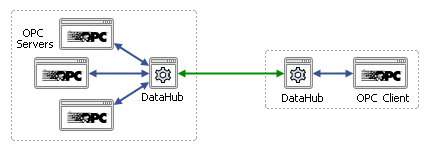| OPC DataHub™ : Version 6.4 | ||
|---|---|---|
 | Chapter 3. OPC Aggregation |  |
Aggregation gives you more access to your OPC data, but why stop there? With the OPC DataHub you can use OPC tunnelling and/or bridging to put the aggregated data where you need it.
OPC bridging means linking data from one OPC server to another OPC server. With the OPC DataHub you can combine aggregation with bridging to bridge multiple OPC servers simultaneously.

This scenario involves aggregating five different OPC servers and then bridging the data between them.
OPC tunnelling means sending OPC data across a network without the hassles of DCOM. Here are a few ways that aggregation can be combined with tunnelling:
Aggregating remote servers uses tunnelling to bring the data from several OPC servers on different machines into one client.

This scenario involves setting up three OPC server machines and one OPC client machine for tunnelling. Aggregation takes place on the OPC client machine.
Remotely connecting to several servers aggregates a group of servers on a single machine and uses tunnelling to connect to a remote client.

This scenario requires aggregating three different OPC servers and configuring the DataHub as a tunnelling master, then setting up the OPC client machine for tunnelling. Aggregation takes place on the OPC server machine.
Many other combinations can be made. These are just a few to get you started.
For more information about using the OPC DataHub to tunnel through firewalls and connect OPC across a network, please refer to Chapter 2, OPC Tunnelling.
Copyright © 1995-2010 by Cogent Real-Time Systems, Inc. All rights reserved.